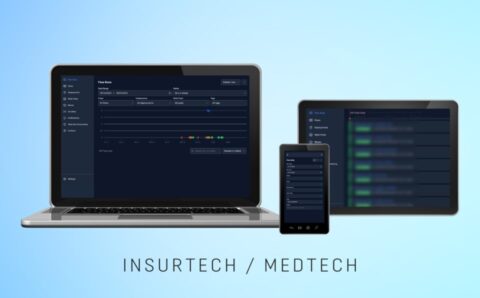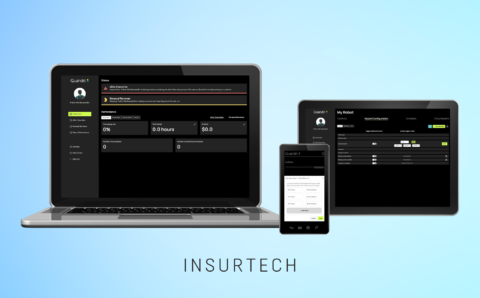
RPA, defined as the employment of software robots to automate a diversity of tasks, offers rich potential to optimize insurance procedures, such as claims processing. This procedure incorporates a lot of routine work and manual engagement, requiring an optimization solution. This is where the opportunities brought by automation are inalienable, which has resulted in the RPA’s popularity continuously growing. Due to this fact, the market size of RPA is expected to grow from $10.01 billion in 2022 to $43.52 billion by 2029 at a CAGR of 23.4%, according to Gitnux.
Let’s discover the value of RPA in insurance claims processing and how automation enhances business performance, elevating its customer service level.
Table of Contents:
The Role of RPA in Insurance Claims Processing
Let’s begin by outlining the role and capabilities RPA services bring to the table regarding claims processing.
Streamlining Data Entry and Validation
RPA excels in automating time-consuming processes of retrieving integral data from various claim forms. Software robots are adept at efficiently navigating within vast loads of information fields, like necessary details that may refer to policyholder data, incident peculiarities, and coverage details. This way, insurers facilitate an accelerated data assembly phase, minimizing the risk of manual errors, as well. The automation approach guarantees that precisely collected and in-depth data sets establish the basis of the productive claims processing workflow.
Precision in claims processing is founded on the thorough validation of details against predefined rules and criteria. The use of RPA systems can optimize the data validation process by cross-referencing extracted data with set guidelines. By automating this procedure, RPA ensures that the claims adhere to policy specifications, regulatory requirements, and internal protocols. This technology is an integral element of accuracy and is able to reduce potential oversights significantly. Therefore, your insurance business achieves a more robust and compliant claims processing system.
Accelerating Document Processing
RPA software is suitable for automating the handling and structurization of documents associated with insurance claims. A diversity of document types, such as healthcare reports or repair estimates to policy documents and photographs, will be accurately categorized with your RPA assistant. Through predefined rules and solid automation algorithms, RPA guarantees that each document is categorized correctly, streamlining the following processing stages. Consequently, your team saves valuable time and mitigates the risk of human imprecision in document sorting.
Extracting required information from various documents is another complex and laborious process within claims processing. RPA enhances efficiency by optimizing the retrieval of relevant details from the relevant documents, like dates, names, and monetary values. With this software solution, you are guaranteed to achieve high accuracy and speed, whether it concerns identifying crucial data points in medical records or retrieving vehicle specificities from accident reports. This capability expedites the assessment process, leading to a more failure-resistant and streamlined claims processing framework.
Enhancing Communication and Collaboration
Automation of communication channels with claimants is another use case of RPA in insurance so that insurers can interact with policyholders more seamlessly and efficiently. Such software can robotize procedures like sending timely claim status updates, acknowledgment emails, and queries for additional information, introducing a transparent and responsive claims journey. As an output, routine communications optimization allows claims specialists to focus on more complex and personalized aspects of customer relations, bringing them to a whole new level. It’s an excellent way to boost customer satisfaction with a more efficient claims resolution process.
Besides, insurance claims processing traditionally requires the engagement of several departments, each comprising particular expertise in the assessment and resolution. RPA can become a perfect mediator for collaboration by smoothly integrating workflows and data transmission among disparate departments of your team. It offers a cohesive and synchronized approach to procedures like connecting claims processing with underwriting or guaranteeing alignment between claims and legal teams. A collaborative optimization cuts down bottlenecks and the chances of miscommunication, speeding up the claims lifecycle.
Streamline Your Insurance Operations
Learn how RPA can revolutionize your claims, underwriting, and customer service processes.
Benefits of RPA in Insurance Claims Processing
As Deloitte insights state, with a payback period of under 12 months, RPA robots contribute an average of 20% of full-time equivalent (FTE) capacity. The technology consistently surpasses expectations in various aspects, including enhanced compliance (92%), increased quality/accuracy (90%), improved productivity (86%), and cost reduction (59%). Let’s consider the benefits RPA has for claims processing.
Improved Accuracy
Claims processing using RPA liquidates the risk of human-made failures by automating data input tasks. An accurate and error-free entry reduces the likelihood of discrepancies in claim information, which may result in severe consequences like customer frustration, inefficiency, higher operational costs, and even the risk of fraud.
Robotic Process Automation claims processing follows predefined rules consistently, facilitating uniformity and standardized procedures. This allows for decreasing variations and enhancing the reliability of insurance claims handling.
Increased Efficiency
Applying qualitative RPA integration services for Insurance ensures reduced processing times and optimized routine procedures for accelerated and accurate claims handling. Besides, the automation technology helps insurers manage higher volumes of claims with current resources, substantially extending operational capabilities. Streamlining various processes, from initial data input to validation, RPA helps insurance agencies grow their efficiency, contributing to a more agile and responsive claims processing system, in turn, highering policyholders’ experience.
Cost Savings
The math of RPA integration cost is simple; with a single, one-time investment, you can gain long-term value for insurance claims processing as well as ongoing cost-saving opportunities. As the above-mentioned resource claims, 81% of companies are investing in this technology to obtain their financial savings objectives. Software bots minimize labor costs related to repetitive tasks, so employees have time to focus on more tangled aspects of claims management. Optimized resource allocation ensures that human expertise is directed toward the fields where it is needed most with strategic manual decision-making, while automated processes handle routine tasks efficiently. This approach elevates the performance and equips you with substantial financial savings, making RPA a valuable tool to enhance claims processing efficiency with operational cost-effectiveness.
Challenges and Considerations
Here are some peculiarities you should keep in mind when it comes to RPA in claims processing.
Integration with Existing Systems
The adoption of automation in insurance necessitates careful consideration of legacy systems. “Legacy technology has had a negative impact on operations for over 60% or two-thirds of the industry despite there being a lot of automation and agility in the US market,” said Piers Williams, global insurance leader at an automation fintech company AutoRek. Pay attention to possible compatibility challenges and carry out meticulous planning to seamlessly incorporate automated processes without disrupting existing operations.
The adoption complexity of RPA in insurance claims processing demands a robust integration strategy. Thus, you should also take care of the challenges related to data synchronization, workflow alignment, and interoperability. These setbacks should be crucially overcome to get the full automation capacity without disrupting the integrity of existing ecosystems. Achieving a seamless and non-breaking integration is key to getting the maximum of automated solutions in claims processing.
Security and Compliance
As Deloitte report claims, insurance companies are experiencing escalating pressure on their compliance functions from internal and external factors. The rise in regulatory requirements, ongoing challenges in talent acquisition, a growing push for cost reductions, and the increasing demand for additional capacity to address emerging risks collectively pose significant challenges for these companies.
Protecting sensitive details throughout automated performance is the primary challenge, so you should consider powerful cybersecurity techniques. Moreover, you should follow altering industry regulations as a trustworthy market player. They demand continuous alertness and adaptation to avoid financial penalties, legal actions, reputational damage, and potential loss of business opportunities. We recommend executing regular and comprehensive control monitoring the regulations’ current requirements to maintain a secure and compliant environment. When handling this issue, insurers have more potential to build trust among policyholders while using the RPA for streamlined claims operations.
Employee Training and Change Management
A smooth integration of RPA involves a critical step of training employees to collaborate effectively with automated systems. For this, you should conduct comprehensive training programs, sharing the skills and knowledge required to work alongside RPA tools seamlessly.
The transition to an automated environment might raise concerns among your team. Change management strategies become a great option in eliminating any apprehensions, creating a positive working environment, and ensuring a successful integration of RPA while maintaining a productive and performant system. This requires the systematic planning, execution, and facilitation of organizational adjustments, as well as transparent communication and comprehensive training, to ensure a successful and smooth transition to automated procedures.
Ready for RPA Implementation?
Let our experts guide you through a seamless RPA integration process, tailored to your specific needs.
Real-world Examples
The use of RPA for claims processing can be showcased by real market stories. A great illustration is Geico. Leveraging the RPA technology, this US-based company has streamlined various aspects of the claims management process, boosting their speed and accuracy. Geico has delegated repetitive and rule-based task execution to software bots, optimizing data entry and document processing, as well as minimizing the pressure on manual resources. The company’s adoption of RPA aligns with its commitment to employing innovative technologies to optimize operations and deliver high-quality services.
Summarizing the information from RPA implementations in the insurance sector provides valuable insights for your future endeavors as well. Therefore, you should prioritize the importance of a well-thought-out implementation strategy based on thoroughly understanding existing processes. As a result, you’ll be able to identify suitable tasks for automation, establishing clear goals and Key Performance Indicators (KPIs) to be achieved with RPA.
In addition, create effective change management plans, focusing on communication and addressing employee concerns as soon as possible. Provide robust guidance to experience smoother transitions and higher acceptance of RPA among your staff.
Furthermore, think about scalability in advance. Successful implementations often start small, focusing on specific processes before gradually expanding automation efforts. This phased approach allows for better control, risk management, and the ability to refine processes based on real market feedback.

Santé.app
With Santé.app, users can navigate health insurance options effortlessly, leveraging automated surveys to get fully personalized recommendations.

AI Platform
Platform that automates processes, transforming patient services & resource management in medical institutions for greater efficiency.

Robot Factory
We developed Robot Factory software to simplify insurance automation, offering a user-friendly interface and efficient document management tools.
Future Trends in RPA for Insurance Claims Processing
Continuous improvements in RPA technology, such as enhanced Artificial Intelligence (AI) capabilities and more sophisticated algorithms, will enable insurers to automate sophisticated tasks with higher precision and speed. According to a McKinsey report, the profound influence of AI and related technologies on the insurance industry extends across its various directions, transforming processes from distribution and underwriting to pricing and claims. Presently, advanced technologies and data are already modifying distribution and underwriting practices, enabling the precise pricing, purchase, and binding of policies in near real-time.
A comprehensive forecast of the insurance sector for 2030 shows changes throughout the industry’s value chain. The insurance purchasing experience is projected to become faster, with mere active involvement from both insurers and customers. AI algorithms, armed with information on individual behavior, will be able to build risk profiles, significantly reducing the time required to complete the purchase of auto, commercial, or life policies to minutes or even seconds. Furthermore, AI applies a group of algorithms that monitor incoming data and stop security threats within fraud predictions and detection capabilities.
AI’s cognitive power can be integrated with RPA for claims processing can ensure advanced decision support, improving accuracy within data investigation and streamlining the settlement process. Insurers may get intelligent data analysis, sentiment analysis in customer communication, and predictive analytics for claims assessment at their disposal.
Conclusion
The adoption of RPA into insurance holds a broad spectrum of potential and benefits. Improved efficiency, reduced errors, and accelerated claims settlements are among the core advantages that redefine manual, inefficient, and time-consuming workflows.
The integration of RPA in the claims processing sector becomes essential for businesses seeking to obtain exceptional performance and customer service, with the opportunity to save operational costs on a long-term basis. Embrace ongoing technological advancements of RPA that will keep up with the dynamic field of automation, making your business credible, productive, and successful. Optimize claims processing in RPA and ensure that your company remains outstanding, resilient, and capable of meeting the growing demands of the industry.
Looking further, the future of insurance claims processing can be truly transformed with the seamless integration of RPA. The RPA facilitates not only operational excellence but also heightened customer satisfaction, positioning you for prosperity and fruitful policyholders serving in the insurance industry.

